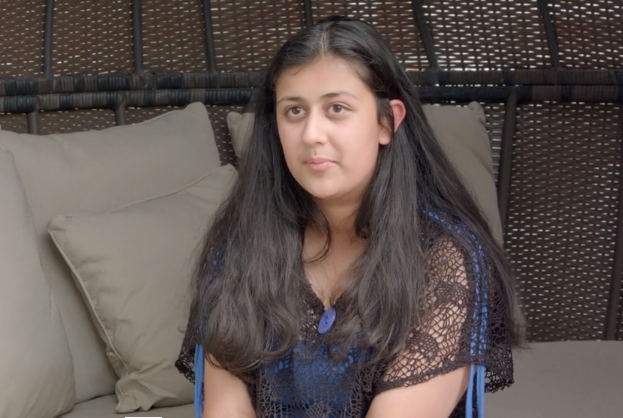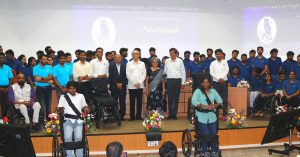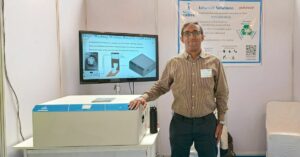Bio-Plastic From Prawn Shells? This 15-Year-Old School Girl Has Made It!
Flexible and sturdy, the bio-inspired plastic made by Angelina Arora may be an affordable and sustainable way of reducing seafood waste produced in India.

When 15-year-old Angelina Arora saw the huge number of plastic bags being carried out of a Sydney supermarket, the first thing that came to her mind was the immense environmental damage caused by these one-use conveniences. A student of Sydney Girls High School, the Australia-based budding scientist decided to look for biodegradable alternatives.
Experimenting with compounds made from everyday household items (such as glycerin, corn starch, potato starch and vinegar), Angelina created six bioplastics and put them through five tests, including testing for clarity, endurance and decomposition.
These experiments led to Angelina picking up the first prize in chemistry in her age bracket at the STANSW Young Scientist Awards 2016, for designing a different plastic made out of corn starch (though biodegradable, it dissolved on contact with water, making it impractical for everyday use).
As a result, Angelina was introduced to top scientists at Commonwealth Scientific and Industrial Research Organisation (CSIRO) who are now mentoring her through her current project — turning discarded prawn shells into bio-plastic!

The young student was at her local fish and chip shop, looking at all the discarded seafood waste (piles of crab and prawn shells, all destined for the bin), when she was struck by the though that there had to be a better, more sustainable way of disposing them.
So she took a few kilograms of discarded prawn shells to her school science lab and got to work. Her consistent and well-researched experiments soon yielded result when she succeeded in using shrimp shells to create a strong, light and biodegradable plastic.
Prawn shells consist of a hard yet flexible protein called chitosan, a version of chitin — the second most abundant organic material on the planet, that is found in fungal cells, insect exoskeletons, spider webs and crustacean shells.

Photo Source: Prawn Shells (L)/ Chitin extract (R)
With help from her mentors’ guidance and a litre of hydrochloric acid, Angelina managed to extract this versatile protein from the prawn shells and combined it with fibroin, a extremely sticky protein that she extracted from the silk of silkworms.
“It is the same protein that spiders use to make webs. It’s very sticky. When you mix it with chitin, it produces a fabric that is flexible, strong and exhibits all the properties you want in plastic.
In short, the final material has the strength of a prawn’s shell and the flexibility of a spider’s web. The plastic also degrades completely with nothing harmful left behind”, Angelina explained to The Sydney Morning Herald, adding that while the shells needed a lot of preparation before being used, it was a lot less than what conventional plastics needed.
You May Like: These ‘Plastic’ Bags Are Actually Made of Potato & Tapioca – and Can Become Animal Food on Disposal!
Encouraged by her parents, Nitin and Aashima Arora, Angelina put together a detailed report (accompanied by pictures of the remarkably malleable and sturdy bioplastic she had made) of her innovative work. This led to her being recently awarded the second prize in chemistry at 2017’s STANSW Young Scientist Awards.
The enterprising youngster now hopes that biodegradable alternatives like hers will contribute towards phasing out planet-clogging plastics and cleaning up the environment.
Especially in the world’s oceans — a cause close to Angelina’s heart ever since she found thousands of tiny plastic fragments in the gut of the fish bought from local fishmongers.

This significant global problem is illustrated by fact that the infamous Pacific trash vortex ( the large area of garbage floating in the Pacific Ocean) is primarily made up of plastic debris that fish keep getting entangled in and dying, wreaking havoc on the region’s ecological balance.
Interestingly, a similar project is under way in Egypt’s Nile University in which prawn shells are cleaned, dried, chemically treated, ground and dissolved into a solution that dries into thin films of plastic.
“If commercialized, this could really help us decrease our waste. And it could help us improve our food exports because the plastic has antimicrobial and antibacterial properties,” says Irene Samy, a professor overseeing the project, told Reuters.
In India, a country with an extremely long coast-line, fishermen and seafood vendors are always looking for economically viable ways to dispose of discard prawn shells. In fact, they often have to pay to get it cleared away.

Instead of throwing these readily available shells away, they can be used to make fully compostable plastic bags. Not only is it more sustainable in the long run, it can also reduce the amount of food waste produced in the country.
Researchers at at Harvard’s Wyss Institute also say that there is plenty of room for growth. Literally, in fact: the nutrients in this bio-inspired plastic makes an excellent fertilizer after its broken down. Working towards fine-tuning its commercial manufacturing, they have been able to already make fully biodegradable products such as egg cartons, chess pieces and even cell phones.
Also Read: How Thousands of Children in Pune Prevented Over 50 Tonnes of Plastic from Reaching the Sea
Like this story? Or have something to share? Write to us: [email protected], or connect with us on Facebook and Twitter.
NEW: Click here to get positive news on WhatsApp!
This story made me
- 97
- 121
- 89
- 167
Tell Us More
We bring stories straight from the heart of India, to inspire millions and create a wave of impact. Our positive movement is growing bigger everyday, and we would love for you to join it.
Please contribute whatever you can, every little penny helps our team in bringing you more stories that support dreams and spread hope.



















